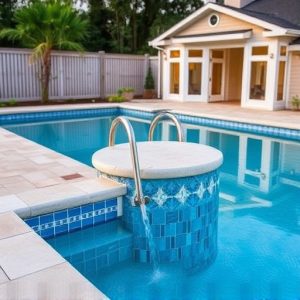Inground Pool Safety: Alarms and Best Practices for Secure Enjoyment
Swimming pool alarms are a critical safety measure for inground pools, designed to immediately alert…….
Swimming pool alarms are a critical safety measure for inground pools, designed to immediately alert homeowners or lifeguards to unauthorized or accidental entries into the pool, thereby preventing potential drowning incidents. These alarms come in two types—surface wave alarms and immersion sensors—with the most effective approach being to use both for comprehensive coverage. Surface wave alarms detect unusual disturbances on the water's surface, effectively distinguishing between regular activity and unauthorized access, while immersion sensors are triggered by contact with the water, ideal for identifying falls from outside the pool. These alarms should be strategically placed around the pool perimeter and maintained regularly to ensure they function correctly.
A complete inground pool safety strategy also includes robust physical barriers like fences with secure gates, clear emergency exits, and prominent safety signage, along with readily accessible rescue equipment. Regular checks of all safety apparatuses and training for adults in CPR and water safety are essential, particularly when children are present. Additionally, practicing emergency response drills with household members reinforces preparedness. By integrating these alarms into a comprehensive safety plan that includes both technological and human elements, pool owners can significantly enhance the safety of their inground pools and reduce the risk of drowning incidents.
When it comes to inground pool safety, vigilance and proactive measures are paramount. This article delves into the critical aspects of ensuring a safe swimming environment, emphasizing the integration of essential features and adherence to best practices. A pivotal component in this safety framework is the utilization of swimming pool alarms for inground pools, which play a crucial role in preventing tragic accidents. We will explore the types of pool alarms available, their optimal installation methods, and the importance of having robust emergency response plans in place for inground pool owners. Dive into the article to learn how to enhance safety and protect your loved ones around the water.
Inground Pool Safety: Essential Features and Best Practices
When prioritizing safety in inground pools, installing reliable swimming pool alarms is non-negotiable. These devices serve as a critical line of defense against drowning incidents by automatically alerting owners when the pool has been breached, either by a child or an unauthorized individual. A key feature to consider is the alarm’s sensitivity and response time; it should be both swift in detection and specific enough to avoid false alarms. Additionally, these alarms can be integrated with other safety systems for comprehensive protection. It’s also advisable to have multiple alarms placed at different access points to ensure full perimeter coverage. The best models offer both surface motion and water level sensors, providing dual layers of detection that are crucial for alertness around the pool.
Beyond alarms, adhering to best practices in inground pool safety is equally vital. This includes maintaining clear and accessible emergency exits, ensuring proper signage for safety rules, and keeping rescue equipment, such as life rings and a reach-and-throw rope, within immediate reach. Regular inspection and maintenance of all safety devices are imperative, as well as ensuring that all pool users, especially children, are supervised at all times by a responsible adult who is trained in CPR and water safety. Furthermore, installing pool barriers, such as fences with self-closing and self-latching gates, can significantly reduce the risk of unauthorized access. Regularly reviewing and practicing emergency procedures with your household can further enhance safety protocols around inground pools.
The Role of Swimming Pool Alarms for Inground Pools in Preventing Accidents
Swimming pool alarms for inground pools play a pivotal role in enhancing safety measures and preventing tragic accidents. These alarm systems are designed to detect unauthorized or accidental entries into the pool area, providing an audible alert that can deter potential drownings, especially when supervision is lacking. The advanced technology behind these alarms includes motion sensors and water surface displacement detectors that are tailored to work effectively with the specific dimensions of inground pools. By setting a perimeter around the pool, these systems create a safety buffer that acts as a guardian, notifying homeowners or lifeguards immediately upon sensing movement beyond the pool’s edge. This proactive approach to inground pool safety is crucial in high-risk environments such as private residences with young children or in public areas where constant oversight may be impossible.
Furthermore, swimming pool alarms for inground pools are a complementary safety feature that works in tandem with physical barriers like fences and gates. They serve as an additional layer of protection by offering real-time monitoring capabilities. When integrated into a comprehensive safety plan that includes educational programs on water safety, these alarms significantly reduce the likelihood of accidental falls or unintended access to the pool. It is imperative for pool owners to consider the installation of such alarms as part of their responsibility to ensure the well-being of all users and to mitigate the risk of drowning incidents. Regular maintenance and testing of these systems are essential to guarantee their reliability and effectiveness in safeguarding inground pools.
Maintaining a Watchful Eye: Types and Installation of Pool Alarms
When it comes to ensuring the safety of an inground pool, maintaining a watchful eye is paramount. Swimming pool alarms for inground pools serve as a critical layer of security, offering immediate notification in the event of unauthorized access or potential drowning incidents. These alarms can be categorized into two main types: surface wave alarms and immersion sensors. Surface wave alarms detect unusual water disturbances caused by a person entering the pool, which differentiates them from normal activities like swimming or diving. They are highly sensitive to changes on the water’s surface and can be a deterrent to unauthorized users due to their audible alarm activation. On the other hand, immersion sensors are designed to trigger an alert when they come into contact with water, making them effective at detecting falls into the pool from the surrounding area.
For optimal safety, it’s recommended to combine both types of alarms for comprehensive coverage. The installation process is relatively straightforward and typically involves placing the surface wave alarm on the pool deck or ledge at a point where it can survey the entire water surface. The immersion sensor should be installed in a similar location but is less concerned with surface disturbances and more focused on detecting the presence of someone in the water. Both types of alarms are designed to be user-friendly, with many models featuring battery operation for easy setup without the need for complex wiring. It’s important to regularly test these alarms to ensure they are functioning correctly, as they can be a lifesaving tool in preventing tragic accidents. Proper maintenance and regular checks guarantee that pool alarms remain a dependable safety measure for inground pools.
Emergency Preparedness and Response Plans for Inground Pool Owners
When prioritizing inground pool safety, emergency preparedness and a swift response plan are critical components. As an inground pool owner, it’s imperative to have readily available safety equipment such as life rings, reaching poles, and first aid kits. However, the most effective tool for enhancing safety is the installation of swimming pool alarms designed specifically for inground pools. These alarms are designed to detect any unauthorized or accidental entries into the pool and sound an alarm to alert the owner or nearby individuals immediately. It’s essential to test these alarms regularly and ensure they are maintained in optimal working condition.
Furthermore, a comprehensive emergency response plan should be established and practiced with all household members. This includes knowing the location of safety equipment, understanding pool barriers, and being familiar with cardiopulmonary resuscitation (CPR) techniques. Additionally, clear signage around the pool area that displays emergency contact numbers and the location of the nearest medical facility can facilitate a quicker response in critical situations. Regularly reviewing and updating the plan, especially after any changes to the pool environment or household members, ensures that everyone knows how to react effectively if an emergency arises.


